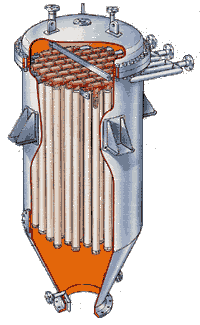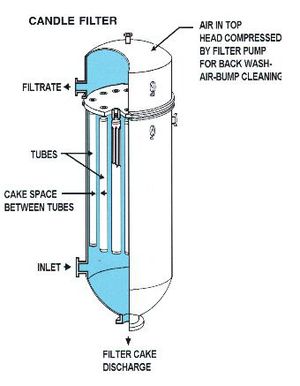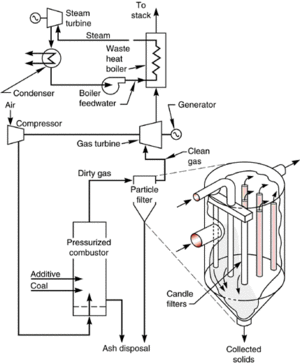Candle Filters
The Candle Filters are, as all pressure filters, operating on a batch cycle and may be seen in process lines handling titanium dioxide, flue gas, brine clarification, red mud, china clay, fine chemicals and many other applications that require efficient low moisture cake filtration or high degree of polishing.
Candle Filters are also used for thickening to produce a concentrated flowable slurry by partial removal of the liquid phase as filtrate. This mode of operation is possible since Candle Filters may operate on very short cycle times taking advantage of the high filtration rates whilst the cakes are still thin. One of the features of Candle Filters when used for thickening is their clear filtrate since gravity Thickeners, in analogy, produce overflows which always contain a certain amount of fine suspended solids.
Another feature of Candle Filters is the cylindrical shape of the elements that retain the formed cake. This shape, opposed to Plate, Leaf or Filterpresses, increases the filtration area as cakes grow thicker and compensate to some extent to the decrease in filtration rates.
Candle Filters are very well suited for handling flammable, toxic and corrosive materials since they are autoclaved and designed for hazardous environments when high pressure and safe operation are required. Likewise, they may be readily jacketed for applications whenever hot or cold temperatures are to be preserved. These features are not possible on Filterpresses which require the opening of plates to the atmosphere by one to allow cake discharge at the end of each cycle.
Candle Filters are available in all sizes and the larger types may have an area of 200 m2 and contain 250 or more filtering elements installed in a 2.5 to 3.0 meter diameter vessels. The operating pressure range is quite wide but most of the Candle Filters operate at a pressure of 6 bars.
Components
The Candle Filter consists of three major components:
- The vessel
- The filtering elements
- The cake discharge mechanism
Advantages
- Excellent cake discharge.
- Adapts readily to slurry thickening.
- Minimum floor space.
- Mechanically simple since there are no complex sealing glands or bearings.
Disadvantages
- High headroom is required for dismantling the filtering elements.
- The emptying of the vessel in between cake filtration, washing and drying requires close monitoring of the pressure inside the vessel to ensure that the cake holds on to the candles.
Maintenance
The Candle Filter requires attention on a regular basis to safety devices and automation features that accompany modern filters. The space above the filter should have a hoisting device and sufficient headroom to lift each candle and move it horizontally to a location adjacent to the filter tank. It is recommended to have a special rig that will hold the candle for maintenance. Space must also be allocated for the cover which may be either hinged or removed. The major components that require attention are:
- The filter tank must conform to an Unfired Pressure Vessel code, such as ASME, and checked periodically as required by the safety regulations.
- The pressure relief valve that is located on the top of the tank must be checked for emergency functioning.
- The clamps that seal the upper and lower ends of the filtering medium to the core.
- The large diameter caulking gasket of the dished top head cover. The ends must be cut in an angle to ensure a perfect seal.
- The hinged head cover locking bolts.
- The cleanliness of the filtrate sight glass that monitor on-line or visually enables inspection of the filtrate clarity.
- The interlock that disables opening the cake discharge when the vessel is still under pressure.
- The maintenance hoist above the filter must pull out the candles vertically so that they will not hit the tank wall.
- The condition of the filter medium, cloth or mesh screen, must be done periodically to ensure that they are not damaged.
- The vent on top of the head must be checked for free evacuation of air.
- The filter must not be overfilled with cake since this causes the candles to bend so they must be checked periodically.
Video


